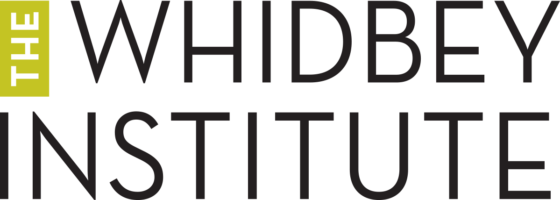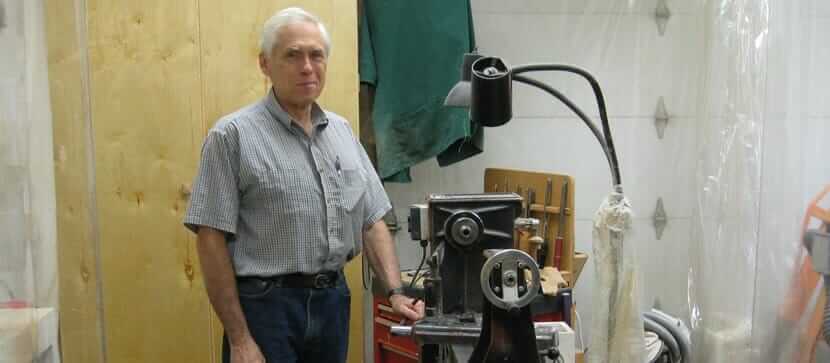When visitors to the Institute come into our office, their eyes are irresistibly drawn to something in the back: the stunning wood pieces of Terry Bourk, arrayed on the shelves behind where I sit.
From bowls to vases to impossibly delicate goblets, the pieces capture the distinctive qualities of a variety of hardwoods from Whidbey Institute land. The woodturnings never fail to mesmerize viewers with their natural yet refined quality, the way the roughness of the bark dances with a tree’s smooth core, and their organic hues, as if they just sprouted from the land where the wood first matured.
I recently visited Terry at his home in Clinton where he spoke about his passion for the art of working with wood, his ties to the Whidbey Institute, and what inspires him to give to the Institute in this special way.
A family activity, and a hobby that turned into more
As a teenager, Terry helped his father build two boats, one while he was in high school, and the other during summer break in college. Later as a graduate student at MIT, Terry had access to a hobby center to students, where he built some cabinets and a loom for his wife Penelope, a mythologist who works with fiber and wood.
“Back then,” Terry said, “woodworking was a refreshing counterpoint to the high-tech engineering studies, and a welcome escape from the drudgery of writing my PhD thesis.”
For many years after that, with the budget constraints of a growing family, woodworking for Terry was part of home maintenance and included simple furniture construction. The activity also served as a “pressure release valve” from all the head-work and the lack of hands-on work, managing engineering projects for wireless technology startup companies in San Diego. This all changed about 10 years ago, when Terry attended an introductory woodturning course. Although his previous woodwork had been self-taught, he felt a little apprehensive about lathe work, particularly with the large pieces of wood he imagined turning. Yet after three sessions with a skilled instructor, Terry was hooked.
“I jumped in,” he said, with a smile, recalling the turning point. “I ordered a large, specialized lathe built in Australia and waited impatiently two months for it to arrive.” His initial training gave him confidence, even with large heavy pieces of wood. For instance, a tall hollow form vase now part of the Institute collection, was turned from a nearly three hundred pound block of wood from the aging madrona (arbutus) felled for safety reasons, near the camping meadow.
A passion revealed
Entering the Bourk home is a bit like crawling inside a violin; you’re surrounded by wood in various phases of transformation: trunks of trees in their unaltered states, sculpted pieces drying after being turned, and finished ones gleaming with full-bodied color after having the finish applied to them. Shelves lining the walls are filled with plates, bowls, and vases. Picturing Terry bent over the lathe, I wondered: how many hours am I staring at? I could hardly fathom a guess.
The lathe was located in his garage/shop, in the very back corner, enclosed by a plastic curtain to contain the flying wood chips. Though Terry didn’t do a demo for me, it didn’t take much imagination to understand the physical demands of the work, the adapted engine hoist just beyond the plastic curtain hinting at the weight of wood roughed for larger turnings. What does he love most about this challenging work?
“I appreciate the freeform aspect of the art,” he said, “and the opportunity to pursue and reveal the character of each piece of wood. It’s a process of discovery. What is inside this piece? Can I guess from what the outside tells me what I will find when I go in? If I know where the wood came from, there is always a story associated with it — what new story am I spinning in the process of engaging with it? On a physical level, you are interacting with the wood not merely by operating machinery but also by guiding the tool to create a shape in a full-body motion. I am literally dancing with it,” Terry explained.
The entire process struck me as a suitable metaphor for everything that shows up in our lives.
A process each its own
Whether it’s cutting the tree, selecting the orientation of pieces to be taken to the lathe, following the character of the wood and shaping the pieces, the steps in controlling the drying process, the tedium of final sanding and ultimately the revelations when the wood finish is applied, there’s no completely reliable step-by-step process. Each piece is different, with any combination of multivariate factors: grain, pattern, bark, damage to the tree. “You can study a particular kind of wood, but in the end you’re at the mercy of the unique traits of the piece you’re dealing with,” Terry said.
The only area of predictability, perhaps, is the general kind of wood: “Fruit woods tend to be particularly difficult to work with because as the wood dries, it distorts, and often cracks. I’ve made a number of pieces from the plum tree which fell during last winter’s storm. The tree was at the end of its life, and much of the core was rotten, so there was not much of it left that was workable. The rot however makes for an array of colors which can produce a striking amount of detail, and so for the artist it was definitely a gift in disguise.”
Does he have a favorite wood, I asked him? “I love the wood of the ironbark eucalyptus – gorgeous, red wood – common, though not native, in California. Especially in San Diego, from which I moved to Whidbey. Also black locust, which neighbors of the Institute offered me from their land recently. But I love the eucalyptus so much that if I learned that there was one that had fallen somewhere in my old state, I would be tempted to get in my truck and drive all the way to San Diego to get it.”
An act of devotion: the reason
How does Terry approach the wood he receives from Chinook? Besides reverently turning each piece into an artifact of earthen beauty, he pretty much returns it all to the source. “Whenever someone provides me with part of a tree, I try to give them back a few of the finished pieces,” he explains. “With the Institute, though, it’s the reverse: most go back to Chinook as gifts to support the Institute’s mission.” Pieces are often offered in gratitude for presentations and service to the Institute.
Why this devotion, I asked him? Why this level of commitment to giving, after all those hours of labor at the lathe? Terry’s answer was simple. “Aside from the reward of the work itself, which I enjoy, I just appreciate the unique trees which come from the land. The story of Chinook is imprinted in each and every one of them, and my impulse is to send the reincarnated woods back to their home territory. It’s my contribution, not only to the spirit of the land but to the work which happens on it.”
By the end of my meeting with him, I was enchanted. I still had many questions. He’s officially retired from his years of service as a wireless executive. How does the former engineer and Bluetooth pioneer plan on spending his liberated days?
He sees a lot of time at the lathe in his near future, churning out pieces – for people, for the Institute, for himself. “Mind you, this is just a hobby – albeit a passionate hobby,” said Terry.
And how blessed are we for that.
– Hannah Lee Jones
Terry’s wood pieces will be used as special thank you gifts for Whidbey Institute’s longtime supporters and donors.

